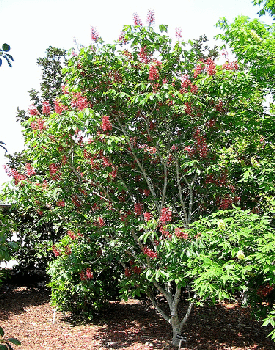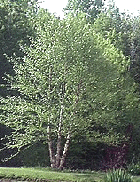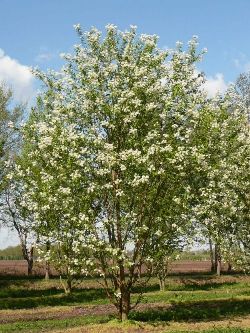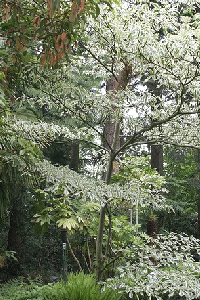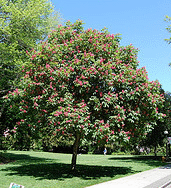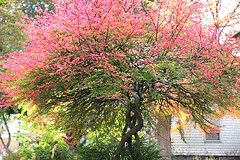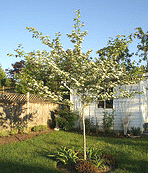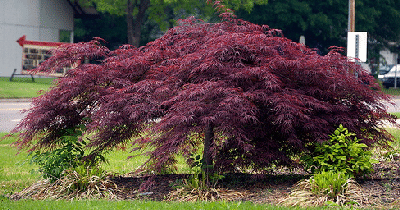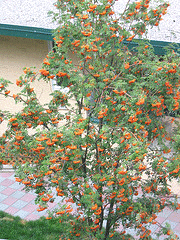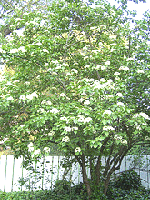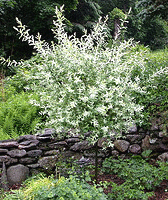Small Ornamental Trees
The Selection of Hardy Ornamental Trees for Midwest and Northern Climates Continues to Grow
Ornamental trees, generally 6 to 25 or 30 feet, typically add year round interest with beautiful shapes, spring flowers and fall colors, berries or seed pods. An ornamental tree can be a rose tree or a grafted evegreen, even a topiary evergreen. Use small and dwarf trees to add a point of interest, shade a patio, or enhance an entryway. Many large shrubs are easily pruned to a small ornamental tree, such as viburnums, late lilacs and winged euonymus. Some are pre-pruned to tree form at the nurseries. Be sure you are willing to maintain the pruning or your ornamental tree will quickly begin to revert to shrub form. Keep one leader branch, removing most horizontal branches from the ground up until the leader is at least 4 feet tall. Then let it branch out.
Small and dwarf ornamental trees benefit from spring fertilization. Use a slow release granular fertilizer with equal parts NPK (nitrogen, phosphorous and potassium). Sprinkle around the root zone according to directions in spring.
Aesculus pavia (Dwarf Red Buckeye)
Zones: 4-9
Sun: Full sun to part shade
Height: 10-20’
Spread: 10-20’
Shape: Rounded dense crown
Growth Rate: Slow to moderate
Soil Preference: Prefers moist well, drained, deeply cultivated soil. Somewhat adaptable.
Moisture: Average to high moisture requirements
Foliage: Large leaves are drooping and dark green, 5 leaflet, coarse texture.
Blooms: 6-9” erect, loose clusters of carmine red flowers in late spring to early summer.
Fruit: Leathery capsules in fall.
The Dwarf Red Buckeye is renowned for being among the first trees to sprout leaves in spring, a full month before oaks and maples. However, come autumn, the leaves are also the first to drop without any remarkable color change.
The early blossoms of this tree serve as an essential food source for hummingbirds. Yet, these early blooms are susceptible to damage from late frosts, particularly in zone 4.
The Dwarf Red Buckeye is a quick bloomer and will flower even when the tree is still very young. To maximize its flowering potential, plant the tree in full to mostly sunny areas.
This small tree tends to form clumps and can be cultivated as a large shrub or multi-trunk tree. Trimming lower lateral branches will help to maintain its tree-like appearance.
Overall, the Dwarf Red Buckeye is a superb choice for a small ornamental tree in woodland gardens or near patios.
Amelanchier canadensis (Shadbush)
Zones: 3-7
Sun: Full sun to part shade
Height: 10-25 feet
Spread: 10-25 feet
Shape: Rounded bushy crown with upright branches
Growth Rate: Moderate
Soil Preference: Moist well drained soil, Neutral to acidic pH. Adaptable to sand, clay or loam
Moisture: Average water needs, moderately drought tolerant
Foliage: Shiny green leaves that are white and fuzzy when young, elliptic toothed leaves
Blooms: White
Fruit: Showy edible fruit
The Shadbush tree can cause confusion in the nursery trade and among botanists, as it is often mistaken for the Downy Serviceberry, Amelendhier arborea. While the two are quite similar, with the main difference being that the Downy Serviceberry blooms earlier and has larger flowers, both are generally multi-stemmed trees or shrubs that can easily be kept in tree form with minimal pruning of the main trunk and stems. Of the serviceberries, the Downy Serviceberry maintains the most tree-like form.
In early spring, just as the leaves are opening, the Downy Serviceberry produces white, upright clusters of flowers, which are followed by tiny red or blue-black fruits that attract birds. The foliage of the Shadbush and Downy Serviceberry is bright green and turns brilliant yellow-orange or red in the fall, making them some of the first trees to color.
Ideally, Amelanchier Shadbush and Downy Serviceberry prefer filtered shade and moist to wet soil, but they are adaptable to drier soil if they receive adequate water during establishment.
Amelanchier commonly produces root suckers, but the grandiflora 'Autumn Brilliance' is less persistent with suckers. While they may occasionally be affected by rust, leaf spot, or powdery mildew, or bothered by leaf miners, borers, or scale, Amelanchier are generally not afflicted with serious disease or insect problems.
They are typically not bothered by deer and have a lovely form that is perfect for shady woodland settings or shrub borders. With moderate salt and pollution tolerance, they are also an excellent choice for street planting.
Amelanchier x grandiflora (‘Autumn Brilliance’)
Zones: 3B-8
Sun: Full sun to part shade
Height: 15-25 feet
Spread: 15-25 feet
Shape: Vase shaped, upright branches
Growth Rate: Moderate to fast
Soil Preference: Average well drained soil, will tolerate a wide range of soils that are well drained.
Moisture: Average water needs, moderately drought tolerant
Foliage: Blue green leaves, finely toothed elliptic leaves
Blooms: White
Fruit: Showy edible fruit
The Juneberry tree, also known as the hybrid Apple Serviceberry, comes in the form of ‘Autumn Brilliance’. It can be maintained as a shrub or pruned periodically to remove side shoots from the trunk.
This Serviceberry is often sold with single or multiple trunks and is easy to maintain in tree form.
In early spring, ‘Autumn Brilliance’ produces large, lightly fragrant, drooping clusters of white blooms tinged with pink, which mature to full white. These blooms are larger than the original Serviceberry hybrid and create a spectacular display. Following the blooms, small, round berries appear, starting out green and turning red before maturing into dark purple-black berries that are sweet and edible.
The leaves of ‘Autumn Brilliance’ start out purplish, then turn blue-green in summer before changing to bright orange-red in autumn.
The outstanding ornamental features of ‘Autumn Brilliance’ make it an excellent specimen tree for the home landscape, and its small size also makes it suitable for shrub borders.
Despite occasional pruning of side shoots and suckers, this tree is generally easy to grow and maintain. If pruning is necessary, it should be done in late winter or early spring. Disease resistance is very good, but the tree may occasionally be attacked by leaf miners or aphids.
This sturdy tree is tough enough to use in the street boulevard or planting strips that are 6 feet wide and is moderately tolerant of soil salt. In five to ten years, ‘Autumn Brilliance’ can grow to be 10 feet tall depending on the conditions.
Amelanchier laevis (Allegheny Serviceberry)
Zones: 4-9
Sun: Full sun, part shade, shade
Height: 15-25 feet
Spread: 15-25 feet
Shape: Vase shaped irregular crown with upright branches
Growth Rate: Moderate
Soil Preference: Moist well drained soil of coarse loam, but will tolerate a range of soils, Neutral to acidic pH.
Moisture: Average water needs, may be sensitive to drought
Foliage: 1-3” simple elliptic leaves, finely toothed, shiny green
Blooms: Lightly fragrant drooping clusters of small white blooms in April or May
Fruit: Showy edible fruit
The Allegheny Serviceberry is a multi-trunk tree or shrub that is highly adaptable to sun, part shade, or shade. It will flower best in full sun, but in more shade, the crown will have a more open and graceful form. Once well established, the Allegheny Serviceberry will be more tolerant to short periods of drought. In consistently moist soil, it will grow tall and fast, potentially reaching a height and width of 30-40 feet under ideal conditions.
Clusters of fragrant white blooms form before the leaves and give way to berries in summer. The edible berries mature from magenta red to purple to dark purple-black, usually in June, hence the name "Juneberry". The berries are a good source of iron and copper and are juicier than those of Amelanchier arborea. They have a taste similar to blueberries. The leaves emerge bronzed purple and mature to a shiny green, with dense fine branching. In the fall, the foliage turns red, yellow, or orange.
While the Serviceberry can be somewhat sensitive to disease and insect problems, they are not serious enough to cause significant harm. The Allegheny Serviceberry is very easy to grow and provides year-round interest in the landscape. The flowers will attract bees and butterflies in the spring, and the berries will attract birds, minimizing berry litter. The Allegheny Serviceberry is very similar to the Amelanchier arborea Downy Serviceberry, with the only notable difference being that the Allegheny Serviceberry has a smooth, hairless leaf, purple-bronze new growth, and a sweeter, juicier berry.
With a fine texture and graceful appearance, the Allegheny Serviceberry is an excellent choice for shrub borders, woodland edges, or ornamental accent trees. It is moderately tolerant of air and soil salt as well as urban pollution, making it suitable for use as a street or boulevard tree. Maintaining the tree form will require occasional pruning, but it is easiest to maintain if purchased pruned to tree form. When planted 10 to 20 feet apart in shrub form and left unpruned, they will form a tall, informal hedge or privacy screen.
River Birch
Full Sun to part shade
Zones 2-8
River Birch trees are an excellent choice for moist areas due to their preference for moist soil. They have beautiful exfoliating bark and display bright gold fall color. Typically, Birch trees have an oval form and multiple trunks. They do best in cold northern climates and cannot tolerate shade.
River Birch trees produce both male and female flowers. The male flowers, in the form of long catkins, are produced in autumn and remain on the tree throughout the winter. In the spring, the male catkins produce a significant amount of pollen. Female catkins are produced in spring, are pollinated, and eventually form fruit, which is an inch-long "cone" filled with seed. Some birch trees tend to sucker, making them difficult to control.
Many cultivars of Birch are hardy to zone 2, with some reaching as tall as 70 feet. River Birch does best in a moist, well-drained site but can tolerate compacted soils and wet conditions. Another hardy, smaller Birch variety is Betula pendula 'Youngii', which grows from 6 to 12 feet with "weeping" branches that droop toward the ground.
Birch trees tend to have a shorter life expectancy than most trees but grow quickly. Betula pendula 'Youngii' is hardy to zone 3.
Blue Beech
The Minnesota native tree thrives throughout the Midwest and is adaptable to various conditions, including shade, drought, or heavy moisture.
Its foliage spreads wide and turns a beautiful orange-red color in the fall.
This tree is also known as the musclewood tree due to the muscular twist of its bark.
It can grow up to 25 feet in height and width.
Bradford Pear
Although a beautiful flowering tree, it is essential to mention this tree's serious weaknesses.
Despite its attractiveness and temptation to plant, it has a very unreliable performance due to its extreme susceptibility to wind and ice damage.
This tree often loses large limbs or even topples completely during strong winter winds combined with snow and ice build-up, especially in northern and Midwest climates.
Additionally, the tree's blooms produce an unpleasant smell, and the fruit can be messy. Despite these issues, when planted in the right place, it can still be a beautiful and well-shaped tree.
Amur Chokecherry (Prunus mackii)
Full sun
Hardy in zones 4-6.
This tree boasts a rounded shape and produces abundant white flowers in the spring, followed by small black berries in the fall. The shiny bronze bark is particularly striking against a snowy landscape, making it a popular choice for planting. However, it requires moist, well-drained soil to thrive.
Mackii is known to be less susceptible to disease and insects compared to other trees in the Prunus genus. It can grow up to 20-30 feet in height and 25-30 feet wide. It is available in both clump and single trunk varieties but requires pruning to maintain its tree form.
Sometimes referred to as simply Amur Cherry, there have been claims of its hardiness to zone 2.
Chinese Dogwood (Cornus kousa)
Part to Full Sun
Zones 5-8
In early spring, just after the tree begins to leaf out, this tree displays showy flowerheads that last into early summer. The petals gradually change from white to pink, adding to its beauty. The branching form is lovely, and in autumn, the foliage turns a brilliant bronze color, complemented by bright red fruit that is similar in size and color to a raspberry.
Both birds and butterflies are attracted to this flowering ornamental. It grows well in average, well-drained soil with medium moisture, but it does not tolerate drought well, so it's important to keep it watered in dry spells. It can reach up to 18-25 feet in height and 25 feet in width. This tree displays good cold hardiness, and while claims of hardiness to zones 3 and 4 have been made, it may be risky.
Cornus kousa, the variety of this tree being described, is more disease-resistant than Cornus florida and performs better in midwestern areas.
Crab Apple
Full Sun
Hardiness varies, generally hardy in zones 4-8.
To thrive, fruit trees require well-drained loamy soil and good air circulation to keep their leaves dry, as wet leaves can promote diseases that fruit trees are prone to. Many crabapple trees form flower buds early, which makes them susceptible to frost damage. Therefore, it is recommended to choose crab trees hardy enough for zone 4 that bud a little later.
Rabbit and rodent damage can be an issue during winter, particularly for the bark and young stems of crab apple trees. To prevent this, wrap the stems/trunk with a collar or hardware cloth available at garden centers for protection.
A wide range of crabapple varieties and forms are available, with most spring flower shows being spectacular, especially on larger trees. Crab trees can range in size from 15 to 25 feet and have rounded, oval, pyramid, or weeping shapes, making it easy to find one suitable for any spot. Disease-resistant foliage should be sought after. Some of the best varieties for zone 4 include 'Prairie Fire', 'Sparkler', 'Indian Summer', 'Donald Wyman', 'Adams', and 'Louisa Weeping Crab'.
There are many more crabapple tree varieties available, so it's worth checking them all out at garden centers. It's important to note that fruit trees of any kind do not tolerate wet soils, so it's best to avoid clay and plant them in well-drained loamy soil.
Pagoda Dogwood
Part Shade to full sun
Hardy in zones 3-6.
The dogwood's graceful horizontal branching is rare among northern hardy trees, similar to the Hawthorn. Creamy flower clusters appear in spring, emitting a lovely fragrance. In fall, the foliage turns purplish-red and dark fruits are produced. This Minnesota native can tolerate some shade and is hardy to zone 4, reaching 10-15 feet in height and 20-25 feet in spread.
'Argentea' is another hardy variety, which should be hardy all the way to zone 3, but it may be challenging to find. Its small green leaves are heavily marked with white, producing strikingly bright leaves and highly fragrant white blooms. This tall shrub reaches 15 feet high and 20-25 feet wide and requires base pruning to form a tree.
'Venus' is another variety that may be hardy to zone 4 if you can find one. It grows up to 20 feet in height and 20-30 feet in width, producing fast-growing 6-inch white blooms in spring. It prefers sun to part shade.
Several hardy flowering dogwood varieties are available with standard branching structures and beautiful spring flowering. They generally grow well in most ordinary soils but prefer moist, well-drained soil. Most are hardy to zone 5, with some being hardy to zone 4.
Aesculus x carnea ‘Briotii’ (Ruby Red Horse Chestnut)
Zones: 5-8
Sun: Full sun to part shade
Height: 25-35’
Spread: 25-35’
Shape: Oval to rounded crown
Growth Rate: Moderate
Soil Preference: Prefers moist, fertile, well drained soil, will tolerate average soil.
Moisture: Average moisture requirements
Foliage: Dark green, 5 leaflet, coarse texture. Turns brown in October
Blooms: 8-10” erect, full clusters of deep red flowers in May
Fruit: 1 1/2” round, prickly, poisonous
The Ruby Red Horsechestnut is a smaller variety than the Red Horse Chestnut. Its flower clusters are larger than the species and deep red in color. Additionally, it is less susceptible to fungal disease. However, dry conditions may cause leaf scorch and overall decline in the tree's health, so it is important to ensure it receives adequate moisture during dry periods.
The 'Briotii' cultivar develops a tap root, making it challenging to move once it is established. The wood of the Horse Chestnut is soft and weak, and heavy snow can cause limbs to break. To encourage a strong structure, it is recommended to prune crossed or wayward interior branches. The Horse Chestnut tree bleeds extensively when pruned, so it should be done in midsummer after new growth has matured and the bloom period is over.
Overall, the Ruby Red Horsechestnut is a very popular cultivar of Aesculus, but it requires proper care to ensure its health and longevity.
Winged Euonymus (Euonymus alatus)
Part to full sun
Zones 4-8.
The 'Burning Bush' tree has a large form, which can be pruned into a striking tree that turns blazing red in the fall. Its bark features corky "wings" that catch and hold snow, providing winter interest with sparkling sunlight.
However, the bark and young stems of Euonymus are vulnerable to rabbit and rodent damage during winter. To protect them, wrap the stems/trunk with a collar or hardware cloth available at garden centers.
This tree can reach a height and spread of 10-15 feet and should be grown in full sun for the best fall color.
Fringe Tree (Chionanthus virginicus)
Full sun to part shade
Hardy in zones 5-8.
The Fringe tree has a slightly rounded and open shape and produces white "fringed" flowers in panicles during late spring. It thrives in moist and fertile soil, but can also tolerate wet conditions.
Both male and female trees exist, with the male tree having slightly more showy flowers. Fruit will only develop if both male and female trees are present.
While hardiness claims have been made for zones 3 and 4, Fringe trees are not commonly found north of zone 5. They typically grow to a height of 15-20 feet.
Thornless Cockspur Hawthorn
Full Sun
Hardy in zones 4-6
The Hawthorn tree, while not as graceful as the Pagoda Dogwood, also has the unique horizontal branching pattern uncommon in northern gardens.
In June, clusters of white flowers (though not pleasantly scented) contrast against the tree's glossy dark leaves. In the fall, the leaves turn bronzy and the tree produces red fruits.
The Hawthorn prefers moist, well-drained soil, but can tolerate drought. To protect the tree from rabbit and rodent damage in winter, wrap the stems and trunk with a collar or hardware cloth, available at garden centers.
The tree is disease-resistant and drought-tolerant, and can reach 15-20 feet in height and spread. Consider looking for the thornless variety Inermis or the smaller Cruzam.
PeeGee Hydrangea
This small but robust tree boasts a show-stopping display with its large creamy flower pyramids in midsummer, which can weigh down its rounded form.
The blooms age to a pinkish bronze color and persist through the winter, making them great for dried arrangements.
Hardy and able to reach heights of 15-20 feet with a similar spread. The 'Grandiflora' variety is slightly smaller, while 'Tardiva' blooms in August and is also a bit smaller in size.
Japanese Tree Lilac
Full sun
Zones 3-7
The Korean Tree Lilac, also known as Syringa reticulata, is a fragrant tree that blooms in spring.
Its 'Ivory Silk' variety has a rounded to oval shape and flowers heavily at a young age. Meanwhile, 'Summer Snow' has a more rounded form and also blooms heavily.
The trunk has a shiny appearance with long horizontal lines, similar to a cherry tree. These trees usually grow up to 30 feet, but there are dwarf varieties that can reach around 15 feet or be grafted onto a trunk.
Be sure to check with your garden center to ensure that a dwarf bush grafted onto a trunk will be hardy in your area. They prefer moist, well-drained soil and can tolerate windy areas.
Tree lilacs typically bloom in June, with heavy blooming occurring every other year. Although the fragrance is similar to old-fashioned lilacs, it can be somewhat fainter and muskier. While some people may find the fragrance unpleasant up close, it is generally not objectionable from a distance.
Magnolia
Full sun
Hardy in zones 5-8
Magnolias put on an incredible show of spring flowers, and if you're lucky enough to be gardening in zones 5 or 6, you've probably already incorporated them into your landscape.
The hardiest variety is the 'Star Magnolia', which can survive well into zone 4 and even 3, but few others will make it through winter if the flower buds form late in the summer.
However, 'Butterflies' has proven to produce a more spectacular spring bloom every year since 1999 in zone 4, so bud damage hasn't been an issue. This variety blooms later than the 'Star Magnolia' and its blooms begin to open just as the 'Star' is dropping its petals.
If you decide to plant a Magnolia in zones 3 or 4, choose a wind-sheltered location away from other trees to avoid root competition and give it the best chance to thrive.
Magnolias prefer moisture-retentive, organically enriched, somewhat acidic soil and generally reach a height of 15-20 feet.
Amur Maple (Acer ginnala)
Full sun to part shade
Hardy in zones 3-6
This shrub forms a clump and can be trained into a tree form or purchased with a single trunk.
Regular pruning may be needed to maintain its tree shape and it has a tendency to self-seed. Amur Maple thrives in well-drained soil with moderate moisture, but can tolerate some drought.
It makes a great screening hedge when left unpruned, but can be pruned to create an impressive specimen plant. 'Embers' variety offers brilliant red foliage in autumn.
With proper pruning and removal of saplings, this elegant tree produces a striking red fall display. It typically grows to 15-20 feet in height and width.
Japanese Maple
Japanese Maples are known for their delicate leaf shapes and colors, as well as their stunning fall displays. However, most varieties are only hardy to zone 5 or 6 and may require pruning to maintain tree form.
It's important to check with your local nursery to find the ones that thrive best in your area. If you're in zone 4, you may have success with the 10-foot A.campestre 'Carnival', which boasts ever-changing leaf colors from spring to fall. The bright green leaves are edged in pink and white on red stems in spring, turning to shades of yellow in fall.
See more information and details: Small Maples and Japanese Maples.
Showy Mountain Ash
Full sun
Hardy in zones 2-7
The 'Sorbus decora' has a slightly rounded to ovoid form with dark green leaves, and it can grow up to 20 feet tall. It is hardy to zone 2.
However, be careful when selecting a Mountain Ash tree as some, such as the Korean Mountain Ash (Sorbus alnifolia), can grow up to 50 feet tall and have an oval to rounded form. The European Mountain Ash, 'Sorbus aucuparia', grows up to 20-40 feet tall and is hardy in zones 4 to 7.
All Mountain Ash trees produce white spring flowers that develop into large showy clusters of bright red-orange fruits that persist throughout winter until the birds consume them.
The leaves are compound and consist of multiple fine leaves on each stem, and they are one of the first to emerge in spring. Mountain Ash is generally pest-resistant, except for borers.
However, the bark and young stems of these trees are vulnerable to damage by rabbits and rodents during winter, so it is recommended to wrap them with a collar or hardware cloth for protection. Although Mountain Ash trees are beautiful, some may produce sucker shoots.
Pussy Willow ‘Kilmarnock’ (Salix caprea)
Full sun
Hardy in zones 4-8
The most commonly used cultivar of pussy willow for gardens is 'Kilmarnock', a male clone, and 'Weeping Sally' is the female equivalent.
This charming little tree has its share of potential issues, but it's still delightful. The branches are stiffly weeping and adorned with catkins, making it beautiful in winter.
The male catkins are showy, about 1 1/2 to 2 inches long, with silvery-white fuzz followed by golden anthers in April and May. Fine green foliage follows.
They are grafted onto erect stems of other willow trees, so their height is determined by the height of the trunk on which they were grafted. They are usually sold as small trees, while the taller ones are marketed as large full standards. If sold on their own roots, they will creep along the ground.
The actual bush grows to 18-24 inches in height. Pussy Willow is fast-growing and prefers moist soil conditions, adapting to pH and tolerating some shade. It's ideal for wet open sites, and transplants easily.
However, it has some drawbacks in a garden or landscape, including insect and disease susceptibility, canker problems, suckers, constant litter under the tree, and wind and ice limb breakage.
Rose Tree, Polar Joy
Full sun to part shade
Hardy in zones 4-7
Finally, there is a tree rose that is hardy enough for zone 4!
Unlike other rose trees that require a lot of maintenance in the North and Midwest, 'Polar Joy' is easy to care for, just like any other tree or shrub.
This beautiful ornamental was introduced by Bailey Nurseries in Minnesota, a renowned expert in winter-hardy plants, in 2007.
The plant is only 4 to 8 feet tall and produces continuous clusters of pink blooms. It is essential to protect this small tree from minimal to moderate winter conditions, and it is recommended to purchase "own root" to ensure it is indeed 'Polar Joy.'
Unlike most rose trees that are grafted to the stem of an unknown variety, 'Polar Joy' is own-root. For detailed instructions on planting, minimal protection, and general care for rose trees, please refer to the rose pages.
Gardeners in zone 4 in Minnesota have praised its hardiness, and it is an exquisite addition to the front entry, patio, or underplanted with groundcover roses or perennials. It also thrives in large containers and can be pruned to control its size, maturing to a 5-8 foot tree.
Russian Olive (Elaeagnus angustifolia)
Full sun
Hardy in zones 2-7
The Russian olive tree's gray-green foliage contrasts beautifully with dark evergreens. It is highly adaptable to varying soil and moisture conditions.
While not a true olive tree, it does produce small flowers and fruit, though they are not particularly noteworthy. Be cautious when planting as it is typically thorny, and consider planting in an area that is not regularly walked or mowed.
This tree is hardy to zone 2 and is resistant to pests and diseases. It is also commonly referred to as the oleaster tree. It can reach a height of 20 feet.
Tiger Eyes Sumac (Rhus typhina ‘Bailtiger’)
Full sun
Zones 3-8
Tiger Eyes Dwarf Sumac can be a stunning tree when pruned to have a few feet of clear trunk. Although it is technically more of a shrub, it can grow quite large and reach 6 feet in 10 years, with a maximum height and spread of 15 and 30 feet, respectively.
When pruned into a tree, it has a wide canopy and the lemon green foliage turns to intense scarlet and orange in the fall. However, this tree requires some maintenance to keep it in tree form and to control its moderate spreading.
It is not as aggressive as other sumac species, but underground runners can send up suckers that need to be removed while the tree is dormant. Nonetheless, Tiger Eyes Dwarf Sumac is a gorgeous specimen tree, particularly when grown as a shrub.
It is hardy in zones 3-8 and prefers full sun to produce the best fall color. Female plants produce reddish fall fruit clusters.
Viburnum
Shade to full sun
Hardy in zones 2-8
The Carlesii shrub, standing at 10 feet tall, can be pruned to a beautiful tree form. Among the many varieties available, the larger shrubs are ideal for this purpose.
The American Cranberry bush, which reaches 8-12 feet and is hardy in zones 2-7, the Blackhaw Viburnum which reaches 12-15 feet and is hardy in zones 4-8, and the European Cranberrybush which reaches 8-12 feet and is hardy in zones 4-8, are all good options.
To achieve the desired effect, prune the young bush hard to one strong central leader, and continue pruning as it grows taller. It is important to prune high enough for easy access to the trunk, but not too high as to make pruning a difficult task. Even a 2-foot trunk can produce an interesting shrub.
Note that the bark and young stems of Viburnum are vulnerable to rabbit and rodent damage during winter, so protecting the stems/trunk with a collar or hardware cloth is recommended. The shrubs mentioned here produce sweet spring blooms and are excellent candidates for pruning to tree form.
Viburnum Nanyberry Tree ‘Viburnum lentago’
Full sun to part shade
Hardy in zones 2
This shrubby tree features upright growth with arching branches and produces white, flat flower clusters in the spring. Its rose-pink fruit turns blue-black in the fall, and the plant is adaptable to various soil types and tolerates occasional drought.
The foliage turns red in the fall, accompanied by the fruit. This tree is hardy to zone 2 and reaches a height of 20 feet. Another tree to consider is the Viburnum Blackhaw Tree, which has horizontal branching similar to the Hawthorn.
It reaches 10-15 feet in height and is hardy in zones 4-8. The Blackhaw Tree also boasts foliage that turns purple-red in the autumn.
Japanese Willow 'Hakuro Nishiki'
Full sun
Hardy in zones 4-9.
The dappled willow, with its cream and pink mottled leaves, is now widely available in garden centers up to zone 4.
While its natural form is a large shrub, nurseries have been grafting this willow onto a hardy trunk and pruning it to an elegant tree shape. Continued pruning of trunk sprouts may be necessary.
For more information, see the detailed article on ‘Hakuro Nishiki’. Another variety, the ‘Flamingo’, is also available. It is similar to the ‘Hakuro Nishiki’, but with stronger branches and leaves, slightly more intense color on young leaves and branches, and a slightly more upright and spreading growth habit.
If you haven't seen these trees in your local garden center yet, they will likely become available soon.
Witch Hazel (Hamamelis virginiana ‘Common Witch Hazel’)
Full sun to part shade
Flowering tree
Hardy in zones 4-8
The vase-shaped Witch Hazel shrub can be easily pruned into a tree form by removing lower foliage. It has an attractive, open form with spidery, fragrant yellow flowers that bloom in October and November after the foliage drops.
The leaves open reddish bronze and turn yellow in the fall. Witch Hazel prefers a cool, moist, acidic soil and is excellent for late autumn interest in natural areas. It reaches 15 feet high and wide, but in ideal conditions, can grow up to 20-25 feet tall.
